Tom Parkinson's monthly column, introducing the diverse range of flora and fauna on show at Sanctuary Lakes.
I like to think that Nature's Rubik is a monthly commentary on how our large and varied flora and fauna are adapting themselves to living around the Sanctuary Lakes Resort. Just like the residents, some of the Flora and Fauna are immigrants while others are natives, some are flourishing while others struggle. I thought it might be interesting if we pulled back the centuries and took a look at what our chunk of land looked like on the cusp of Pre-European and first Settlers and what Flora and Fauna existed then, what newcomers arrived and what remains now?
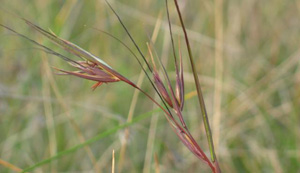 Kangaroo Grass Themeda Trianda Sanctuary Lakes has been established on the fringe of the third largest volcanic plain in the world. The Western Victorian Volcanic Plains covers an area of 2.3 million hectares, more than 10% of the state. The basalt plains were formed by volcanoes over the last 6 million years with the most recent eruption 7,200 years ago. The Aborigines would have seen some of the eruptions as they told stories about rocks and fires coming from the mountains and even a few of their tools have been found amongst the volcanic ash.
Kangaroo Grass Themeda Trianda Sanctuary Lakes has been established on the fringe of the third largest volcanic plain in the world. The Western Victorian Volcanic Plains covers an area of 2.3 million hectares, more than 10% of the state. The basalt plains were formed by volcanoes over the last 6 million years with the most recent eruption 7,200 years ago. The Aborigines would have seen some of the eruptions as they told stories about rocks and fires coming from the mountains and even a few of their tools have been found amongst the volcanic ash.
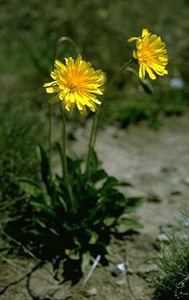 Myrnong or Yam Daisy Microseris Lanceolate According to early European explorers the western plains had an almost park-like setting. How the Aboriginal tribes of the Western Plain engaged with and managed the environment to provide them with food and a wide range of tools is less well known. It is clear that the park-like state of the plains, was partly created by Aboriginal controlled burning and other land management practices over thousands of years.
Myrnong or Yam Daisy Microseris Lanceolate According to early European explorers the western plains had an almost park-like setting. How the Aboriginal tribes of the Western Plain engaged with and managed the environment to provide them with food and a wide range of tools is less well known. It is clear that the park-like state of the plains, was partly created by Aboriginal controlled burning and other land management practices over thousands of years.
The key grasses were Kangaroo Grass Themeda Trianda and Wallaby Grass Astrodanthonia, which as the names suggest attracted mobs of Kangaroos and Wallabies, a key component of the Aborigine protein diet. The various tussock grasses grew abundantly including the Spiky-head Mat-Rush or Basket Grass Lomandra Longiffolia whose seeds were ground by the Aborigine for the basis of damper style bread and its leaves were used for basket making. The most common and often cultivated plant was the Myrnong or Yam Daisy Microseris Lanceolate a staple food of the Aboriginal tribes of the plains. Its tubers were more like a radish than a potato, it had a sweet coconut-like taste and was cultivated in small plots of up to five acres. Aboriginal women used sticks to dig up and separate the tuber-like roots and aerate the soil. They would leave part of the roots for new growth.
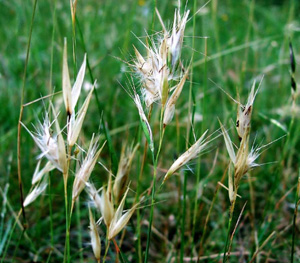 Wallaby Grass Austrodanthonia Unfortunately at my last viewing only the Spikey Head Mat Rush is still growing on the Estate. It can be seen in abundance in the entrance boulevard and around the first, ninth Tee and the putting green. Kangaroo and Wallaby grass has been seeding around the district but as yet none has been seen in Sanctuary Lakes itself. But I am sure it won’t be long before shoots appear on the estate. Unfortunately the same cannot be said for the Yam Daisy which thanks to the introduction of cattle, sheep and goats by the early European colonialist, led to its near extinction. There are a few Victorian Plains communities who have started successfully cultivating them and it would be nice to see a few patches of the colourful Yam Daisy on the Estate.
Wallaby Grass Austrodanthonia Unfortunately at my last viewing only the Spikey Head Mat Rush is still growing on the Estate. It can be seen in abundance in the entrance boulevard and around the first, ninth Tee and the putting green. Kangaroo and Wallaby grass has been seeding around the district but as yet none has been seen in Sanctuary Lakes itself. But I am sure it won’t be long before shoots appear on the estate. Unfortunately the same cannot be said for the Yam Daisy which thanks to the introduction of cattle, sheep and goats by the early European colonialist, led to its near extinction. There are a few Victorian Plains communities who have started successfully cultivating them and it would be nice to see a few patches of the colourful Yam Daisy on the Estate.
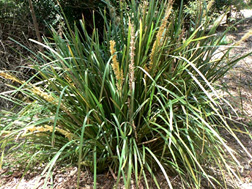 Spiky-head Mat-Rush (Lomandra Longiffolia) Beside the plentiful food on the plains there was also an abundance of seafood to be harvested on our shoreline. This made our location a prime living area for the Aborigine. There were two main tribes in our area the Watha Wurrung who were from the west and bordered the Werribee River and the Bun Wurrung who circled Port Phillip from Mornington Peninsula and the mouth of the Yarra.
Spiky-head Mat-Rush (Lomandra Longiffolia) Beside the plentiful food on the plains there was also an abundance of seafood to be harvested on our shoreline. This made our location a prime living area for the Aborigine. There were two main tribes in our area the Watha Wurrung who were from the west and bordered the Werribee River and the Bun Wurrung who circled Port Phillip from Mornington Peninsula and the mouth of the Yarra.
In the interface between the Watha Wurrung and the Bun Wurrung, and residing on the thin coastal strip from Williamstown to the Werribee River mouth, a separate clan existed, the Yalukit‐Willam. It is unclear to which of the tribal groups Yalukit-Willam belonged possibly one or both, but thanks to the plentiful food, the 200 hundred plus members of the family clan had status and a known generosity.
The first Europeans to pass this way were explorers Hamilton Hume and William Hovell in 1824. They noted 'abundant game and water, the luxuriant growth of grasses and rushes and the general prosperity of the region’s blacks'.
Point Cook was named in 1836 after John M. Cooke, mate of His Majesty's vessel Rattlesnake, commanded by Captain Hobson, the ship that first charted Port Phillip Bay.
The first European pastoralist was William Drayton Taylor who leased the land around Point Cooke promontory in 1849. The following year in 1850 Taylor transferred his licence to Alexander Irvine. Between them they quickly changed the landscape ridding the traditional tussock grasses and Daisy Yams and planting European grasses that suited the sheep and cattle that were transported to graze the promontory.
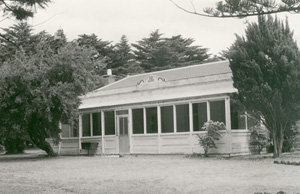 Point Cook Homestead built in stages by Thomas Chirnside from 1850-7 In 1853 the pastoralist Thomas Chirnside bought the freehold of the Point Cook farmlands. In a letter to the then Lieutenant Governor Charles La Trobe, Chirnside described Point Cook as 'the new Eden of the Colony' and that 'the settlers of the area were thoughtful and industrious, willing to put their shoulder to the wheel.' Unfortunately in the same letter he stated that although he tried to be courteous 'he found the natives cunning and treacherous'.
Point Cook Homestead built in stages by Thomas Chirnside from 1850-7 In 1853 the pastoralist Thomas Chirnside bought the freehold of the Point Cook farmlands. In a letter to the then Lieutenant Governor Charles La Trobe, Chirnside described Point Cook as 'the new Eden of the Colony' and that 'the settlers of the area were thoughtful and industrious, willing to put their shoulder to the wheel.' Unfortunately in the same letter he stated that although he tried to be courteous 'he found the natives cunning and treacherous'.
Thomas Chirnside expanded the lands pastoralisation to the whole of the Point Cook area, thereby ridding the land location of all its natural food source, most of the native mammals and with that, the Yalukit-Willam family clan disappeared. Beside the sheep and cattle grazing, Chirnside's deep interest in hunting meant he introduced to Point Cook during the eighteen fifties Deer, Foxes, Rabbits and Hares.
Within a period of less than ten years, the European settlers had radically changed a landscape and a flora and fauna that had taken thousands of years to build.
In next month's Nature's Rubik, we can look at the ongoing Rubik of our Flora and Fauna for the next one hundred and fifty years.